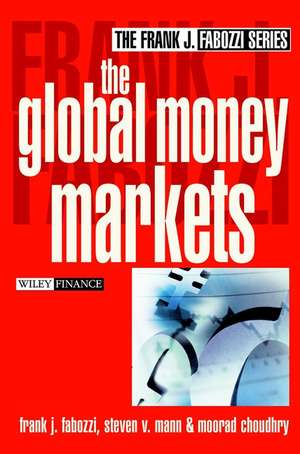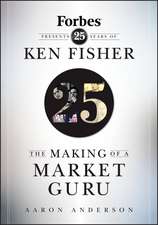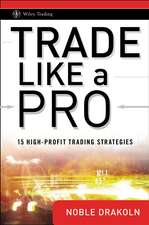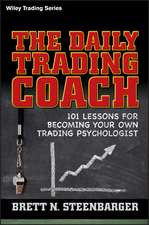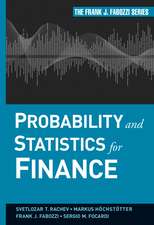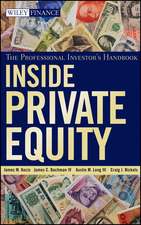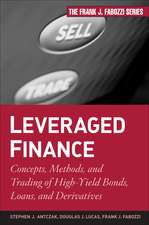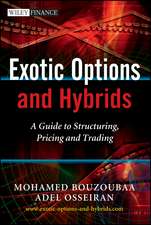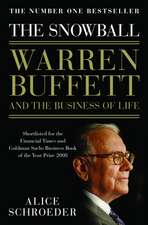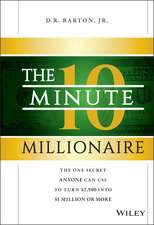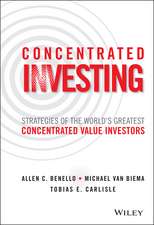The Global Money Markets: Frank J. Fabozzi Series
Autor Frank J. Fabozzi, Steven V. Mann, Moorad Choudhryen Limba Engleză Hardback – 22 aug 2002
Steven V. Mann(Columbia, SC) is Professor of Finance at the Moore School of Business, University of South Carolina. He has coauthored two previous books and numerous articles in the area of investments and works as a consultant to investment/commercial banks throughout the United States. Moorad Choudhry (Surrey, UK) is a Vice President of structured finance services with JPMorganChase in London. Prior to that he worked as a gilt–edged market maker and Treasury trader at ABN Amro Hoare Govett Sterling Bonds Limited, and as a sterling proprietary trader at Hambros Bank Limited. Moorad is a Senior Fellow at the Centre for Mathematical Trading and Finance, City University Business School.
John Wiley & Sons, Inc. is proud to be the publisher of the esteemedFrank J. Fabozzi Series. Comprising nearly 100 titles–which include numerous bestsellersThe Frank J. Fabozzi Seriesis a key resource for finance professionals and academics, strategists and students, and investors. The series is overseen by its eponymous editor, whose expert instruction and presentation of new ideas have been at the forefront of financial publishing for over twenty years. His successful career has provided him with the knowledge, insight, and advice that has led to this comprehensive series.
Frank J. Fabozzi, PhD, CFA, CPA, is Editor of the Journal of Portfolio Management, which is read by thousands of institutional investors, as well as editor or author of over 100 books on finance for the professional and academic markets. Currently, Dr. Fabozzi is an adjunct Professor of Finance at Yale University′s School of Management and on the board of directors of the Guardian Life family of funds and the Black Rock complex of funds.
Din seria Frank J. Fabozzi Series
-
 Preț: 339.16 lei
Preț: 339.16 lei -
 Preț: 355.91 lei
Preț: 355.91 lei - 8%
 Preț: 533.88 lei
Preț: 533.88 lei - 8%
 Preț: 549.23 lei
Preț: 549.23 lei - 8%
 Preț: 409.79 lei
Preț: 409.79 lei - 9%
 Preț: 634.37 lei
Preț: 634.37 lei - 8%
 Preț: 471.71 lei
Preț: 471.71 lei - 8%
 Preț: 422.76 lei
Preț: 422.76 lei -
 Preț: 382.52 lei
Preț: 382.52 lei - 8%
 Preț: 377.01 lei
Preț: 377.01 lei - 8%
 Preț: 539.13 lei
Preț: 539.13 lei - 9%
 Preț: 622.78 lei
Preț: 622.78 lei - 8%
 Preț: 563.84 lei
Preț: 563.84 lei - 8%
 Preț: 447.47 lei
Preț: 447.47 lei - 8%
 Preț: 540.17 lei
Preț: 540.17 lei - 8%
 Preț: 493.96 lei
Preț: 493.96 lei - 8%
 Preț: 444.00 lei
Preț: 444.00 lei - 8%
 Preț: 482.24 lei
Preț: 482.24 lei - 9%
 Preț: 643.77 lei
Preț: 643.77 lei - 9%
 Preț: 609.56 lei
Preț: 609.56 lei - 8%
 Preț: 471.56 lei
Preț: 471.56 lei - 8%
 Preț: 525.77 lei
Preț: 525.77 lei - 8%
 Preț: 547.84 lei
Preț: 547.84 lei - 9%
 Preț: 615.76 lei
Preț: 615.76 lei - 8%
 Preț: 567.07 lei
Preț: 567.07 lei - 8%
 Preț: 449.99 lei
Preț: 449.99 lei - 8%
 Preț: 401.88 lei
Preț: 401.88 lei - 8%
 Preț: 511.00 lei
Preț: 511.00 lei - 8%
 Preț: 420.03 lei
Preț: 420.03 lei - 8%
 Preț: 487.12 lei
Preț: 487.12 lei - 8%
 Preț: 573.33 lei
Preț: 573.33 lei - 8%
 Preț: 371.12 lei
Preț: 371.12 lei - 8%
 Preț: 498.45 lei
Preț: 498.45 lei - 8%
 Preț: 470.75 lei
Preț: 470.75 lei - 8%
 Preț: 419.81 lei
Preț: 419.81 lei - 9%
 Preț: 690.97 lei
Preț: 690.97 lei - 8%
 Preț: 443.70 lei
Preț: 443.70 lei - 8%
 Preț: 526.97 lei
Preț: 526.97 lei - 8%
 Preț: 513.83 lei
Preț: 513.83 lei - 8%
 Preț: 482.24 lei
Preț: 482.24 lei - 8%
 Preț: 550.46 lei
Preț: 550.46 lei - 8%
 Preț: 490.34 lei
Preț: 490.34 lei - 8%
 Preț: 542.40 lei
Preț: 542.40 lei - 9%
 Preț: 612.26 lei
Preț: 612.26 lei - 8%
 Preț: 489.34 lei
Preț: 489.34 lei -
 Preț: 326.63 lei
Preț: 326.63 lei - 8%
 Preț: 471.32 lei
Preț: 471.32 lei - 8%
 Preț: 418.69 lei
Preț: 418.69 lei - 8%
 Preț: 491.96 lei
Preț: 491.96 lei - 8%
 Preț: 536.79 lei
Preț: 536.79 lei
Preț: 521.35 lei
Preț vechi: 566.69 lei
-8% Nou
Puncte Express: 782
Preț estimativ în valută:
99.77€ • 108.34$ • 83.81£
99.77€ • 108.34$ • 83.81£
Carte tipărită la comandă
Livrare economică 18-24 aprilie
Preluare comenzi: 021 569.72.76
Specificații
ISBN-13: 9780471220930
ISBN-10: 0471220930
Pagini: 336
Dimensiuni: 159 x 235 x 25 mm
Greutate: 0.59 kg
Ediția:00003
Editura: Wiley
Seria Frank J. Fabozzi Series
Locul publicării:Hoboken, United States
ISBN-10: 0471220930
Pagini: 336
Dimensiuni: 159 x 235 x 25 mm
Greutate: 0.59 kg
Ediția:00003
Editura: Wiley
Seria Frank J. Fabozzi Series
Locul publicării:Hoboken, United States
Public țintă
Institutional investment managers.Descriere
The
Global
Money
Markets
is
the
ultimate
and
most
comprehensive
guide
to
the
world′s
money
markets
and
the
products
that
make
up
this
vital
element
of
the
global
economy.
Written
in
a
clear,
accessible
style,
and
including
the
most
up–to–date
information,
this
book
is
a
great
resource
for
all
finance
professionals,
including
market
traders,
salespeople,
and
corporate
treasurers.
For the first time, this book brings together the complete range of products used in markets around the world. Through extensive use of real–world examples, case studies, and Bloomberg screens, every aspect of the market is described and analyzed in detail.
The instruments covered include:
∗ Traditional debt instruments such as bills, CDs, and bankers acceptances
∗ Corporate debt products, including commercial paper and medium–term notes
∗ The new range of securitized products, including short–term asset–backed securities and mortgage–backed securities
∗ Asset–backed CP conduits
∗ Floating–rate notes
∗ Derivative instruments, including short–term interest rate futures and swaps
∗ Repurchase and reverse repurchase agreements
This book is the complete reference work on the global money markets, written by the leading names in the business. The Global Money Markets is vital reading for anyone with an interest in money market products, practices, and mechanics.
For the first time, this book brings together the complete range of products used in markets around the world. Through extensive use of real–world examples, case studies, and Bloomberg screens, every aspect of the market is described and analyzed in detail.
The instruments covered include:
∗ Traditional debt instruments such as bills, CDs, and bankers acceptances
∗ Corporate debt products, including commercial paper and medium–term notes
∗ The new range of securitized products, including short–term asset–backed securities and mortgage–backed securities
∗ Asset–backed CP conduits
∗ Floating–rate notes
∗ Derivative instruments, including short–term interest rate futures and swaps
∗ Repurchase and reverse repurchase agreements
This book is the complete reference work on the global money markets, written by the leading names in the business. The Global Money Markets is vital reading for anyone with an interest in money market products, practices, and mechanics.
Textul de pe ultima copertă
The
Global
Money
Markets
is
the
ultimate
and
most
comprehensive
guide
to
the
world′s
money
markets
and
the
products
that
make
up
this
vital
element
of
the
global
economy.
Written
in
a
clear,
accessible
style,
and
including
the
most
up–to–date
information,
this
book
is
a
great
resource
for
all
finance
professionals,
including
market
traders,
salespeople,
and
corporate
treasurers.
For the first time, this book brings together the complete range of products used in markets around the world. Through extensive use of real–world examples, case studies, and Bloomberg screens, every aspect of the market is described and analyzed in detail.
The instruments covered include:
∗ Traditional debt instruments such as bills, CDs, and bankers acceptances
∗ Corporate debt products, including commercial paper and medium–term notes
∗ The new range of securitized products, including short–term asset–backed securities and mortgage–backed securities
∗ Asset–backed CP conduits
∗ Floating–rate notes
∗ Derivative instruments, including short–term interest rate futures and swaps
∗ Repurchase and reverse repurchase agreements
This book is the complete reference work on the global money markets, written by the leading names in the business. The Global Money Markets is vital reading for anyone with an interest in money market products, practices, and mechanics.
For the first time, this book brings together the complete range of products used in markets around the world. Through extensive use of real–world examples, case studies, and Bloomberg screens, every aspect of the market is described and analyzed in detail.
The instruments covered include:
∗ Traditional debt instruments such as bills, CDs, and bankers acceptances
∗ Corporate debt products, including commercial paper and medium–term notes
∗ The new range of securitized products, including short–term asset–backed securities and mortgage–backed securities
∗ Asset–backed CP conduits
∗ Floating–rate notes
∗ Derivative instruments, including short–term interest rate futures and swaps
∗ Repurchase and reverse repurchase agreements
This book is the complete reference work on the global money markets, written by the leading names in the business. The Global Money Markets is vital reading for anyone with an interest in money market products, practices, and mechanics.
Cuprins
About
the
Authors.
Acknowledgements.
Introduction.
Money Market Calculations.
U.S. Treasury Bills.
Agency Instruments.
Corporate Obligations:Commercial Paper and Medium–Term Notes.
Debt Obligations of Financial Institutions.
Floating–Rate Securities.
Repurchase and Reverse Repurchase Agreements.
Short–Term Mortgage–Backed Securities.
Short–Term Asset–Backed Securities.
Futures and Forward Rate Agreements.
Swaps and Caps/Floors.
Asset and Liability Management.
Bank Regulatory Capital.
Index.
Acknowledgements.
Introduction.
Money Market Calculations.
U.S. Treasury Bills.
Agency Instruments.
Corporate Obligations:Commercial Paper and Medium–Term Notes.
Debt Obligations of Financial Institutions.
Floating–Rate Securities.
Repurchase and Reverse Repurchase Agreements.
Short–Term Mortgage–Backed Securities.
Short–Term Asset–Backed Securities.
Futures and Forward Rate Agreements.
Swaps and Caps/Floors.
Asset and Liability Management.
Bank Regulatory Capital.
Index.
Recenzii
Fabozzi,
Mann
and
Choudhry
have
written
an
excellent
introduction
to
the
money
market.
Stigum′s
(2002)Money
Markethas
long
been
the
standard
text
for
this
market,
so
let′s
compare.
For
many
readers,
Fabozzi,
Mann
and
Choudhry
will
be
the
preferred
text.
At
one
quarter
the
length
(328
pages
vs.
1250),
we
might
call
the
new
book
"Stigum
Light."
This
is
not
a
bad
thing.
Many
people
don′t
have
time
to
read
the
entire
Stigum
but
can
get
through
the
shorter
book
in
a
few
sittings.
If
someone
has
a
job
interview
in
a
couple
days
and
needs
to
learn
about
the
money
marketfast,
they
are
going
to
read
Fabozzi,
Mann
and
Choudhry.
The book achieves its relative brevity with only a modest sacrificing in depth of detail. Where it compromises is breadth. While Stigum devotes 400 pages to discussing the major players before proceeding to discuss the instruments that are traded, Fabozzi, Mann and Choudhry focus primarily on the instruments.
Coverage is broad, including Treasuries, agencies, corporate debt, financial institutions′ debt, floaters, repos, short–term MBS and ABS, futures, FRA′s, swaps, caps and floors. They also have nice chapters on asset–liability management and on bank capital requirements.
Whereas Stigum has very few formulas, Fabozzi, Mann and Choudhry is modestly more technical, detailing important pricing and yield calculations. These discussions are accompanied by Bloomberg screen shots that show the reader where the information is coming from. As you are reading, you can check the screen to see if an instrument uses an actual/actual or actual/360 basis. You can grab the current swap curve or check when a coupon is next paid. The screen shots put the examples in context and give the reader a sense of being there on a trading floor.
So how should you choose between the two books? Do you want a book you can read in a week or a book you can read in a month? Do you want a definitive text complete with historical insights and wonderful anecdotes, or do you want a practical shortcut? Do you want a book that is mostly non–technical, or do you want one that covers essential formulas accompanied with Bloomberg screen shots? Do you want a book that covers all aspects of the money markets, or do you want one that focuses primarily on the instruments? Both are available. What are you looking for? ––Riskbook.com
"Fabozzi, Mann and Choudhry have written an excellent introduction to the money market." –– Riskbook.com
The book achieves its relative brevity with only a modest sacrificing in depth of detail. Where it compromises is breadth. While Stigum devotes 400 pages to discussing the major players before proceeding to discuss the instruments that are traded, Fabozzi, Mann and Choudhry focus primarily on the instruments.
Coverage is broad, including Treasuries, agencies, corporate debt, financial institutions′ debt, floaters, repos, short–term MBS and ABS, futures, FRA′s, swaps, caps and floors. They also have nice chapters on asset–liability management and on bank capital requirements.
Whereas Stigum has very few formulas, Fabozzi, Mann and Choudhry is modestly more technical, detailing important pricing and yield calculations. These discussions are accompanied by Bloomberg screen shots that show the reader where the information is coming from. As you are reading, you can check the screen to see if an instrument uses an actual/actual or actual/360 basis. You can grab the current swap curve or check when a coupon is next paid. The screen shots put the examples in context and give the reader a sense of being there on a trading floor.
So how should you choose between the two books? Do you want a book you can read in a week or a book you can read in a month? Do you want a definitive text complete with historical insights and wonderful anecdotes, or do you want a practical shortcut? Do you want a book that is mostly non–technical, or do you want one that covers essential formulas accompanied with Bloomberg screen shots? Do you want a book that covers all aspects of the money markets, or do you want one that focuses primarily on the instruments? Both are available. What are you looking for? ––Riskbook.com
"Fabozzi, Mann and Choudhry have written an excellent introduction to the money market." –– Riskbook.com
Notă biografică
FRANK
J.
FABOZZI,
PhD,
CFA,
is
Editor
of
the
Journal
of
Portfolio
Management
and
an
Adjunct
Professor
of
Finance
at
Yale
University′s
School
of
Management.
Dr.
Fabozzi
is
on
the
board
of
directors
of
the
Guardian
Life
family
of
funds
and
the
BlackRock
complex
of
funds.
He
earned
a
doctorate
in
economics
from
the
City
University
of
New
York
in
1972
and,
in
1994,
received
an
honorary
doctorate
of
humane
letters
from
Nova
Southeastern
University.
Dr.
Fabozzi
is
a
Fellow
of
the
International
Center
for
Finance
at
Yale
University.
STEVEN V. MANN is Professor of Finance at the Moore School of Business, University of South Carolina. He has coauthored two previous books and numerous articles in the area of investments, primarily fixed–income securities and derivatives. Professor Mann is an accomplished teacher, winning seventeen awards for excellence in teaching. He also works as a consultant to investment/commercial banks and has conducted training programs for financial institutions throughout the United States.
MOORAD CHOUDHRY is a Vice President in structured finance services with JPMorgan Chase Bank in London. He traded sterling money markets at ABN Amro Hoare Govett Limited and at Hambros Bank Limited. Moorad is a Fellow of the Centre for Mathematical Trading and Finance, City University Business School, and is Editor of the Journal of Bond Trading and Management. He has written several books in the area of fixed–income securities.
STEVEN V. MANN is Professor of Finance at the Moore School of Business, University of South Carolina. He has coauthored two previous books and numerous articles in the area of investments, primarily fixed–income securities and derivatives. Professor Mann is an accomplished teacher, winning seventeen awards for excellence in teaching. He also works as a consultant to investment/commercial banks and has conducted training programs for financial institutions throughout the United States.
MOORAD CHOUDHRY is a Vice President in structured finance services with JPMorgan Chase Bank in London. He traded sterling money markets at ABN Amro Hoare Govett Limited and at Hambros Bank Limited. Moorad is a Fellow of the Centre for Mathematical Trading and Finance, City University Business School, and is Editor of the Journal of Bond Trading and Management. He has written several books in the area of fixed–income securities.
